Adjusting the Morphology and Properties of SiC Nanowires by Catalyst Control
Abstract
1. Introduction
2. Experimental
2.1. Synthesis of Samples
2.2. Characterization of Samples
3. Results and Discussion
4. Conclusions
- SiC nanowires with pearl-chain-like morphology were prepared using Al2O3 as catalyst. Straight SiC nanowires were prepared with Ni as catalyst. The crystallinity of pearl-chain-like nanowires is slightly higher than that of straight nanowires. The results showed that the efficiency of the nanowires formation depends on the thickness of the catalyst film. Moreover, for the both SiC nanowire samples, the generation of twin structural defects was noticed.
- The main mechanism governing the formation of SiC nanowires in the presence of Al2O3 is the OAG mechanism. In this case, the growth of nanowires is mainly controlled by the amorphous Si–O–Al coated on the surface of the nanowires while the pearl-like beads are generated due to the twin defects. The SiC nanowires grown in the presence of Ni catalyst follow the VLS mechanism. As the temperature increases, and in the presence of the catalyst, the crystallization of SiC is favored, generating the final nanowire structure.
- SiC nanowire samples prepared with two different catalysts have emissions peaks in the visible range at 395 and 465 nm. The emission peaks blue shifted in comparison with the conventional micro-size SiC due to the nanosized dimension of the SiC nanowires, twin defects, and amorphous phases are identified in the samples.
- The two samples have good thermal stability under 1000 °C in air atmosphere. Beyond this temperature, the mass of the material begins to change as a result of some slight oxidation of the material.
Author Contributions
Funding
Conflicts of Interest
References
- Zhang, H.; Ding, W.; He, K.; Li, M. Synthesis and Characterization of Crystalline Silicon Carbide Nanoribbons. Nanoscale Res. Lett. 2010, 5, 1264–1271. [Google Scholar] [CrossRef]
- Li, S.; Wang, N.; Zhao, H.; Du, L. Synthesis and electrical properties of p-type 3C-SiC nanowires. Mater. Lett. 2014, 126, 217–219. [Google Scholar] [CrossRef]
- Wang, H.; Lin, L.; Yang, W.; Xie, Z.; An, L. Preferred Orientation of SiC Nanowires Induced by Substrates. J. Phys. Chem. C 2012, 114, 2591–2594. [Google Scholar] [CrossRef]
- Chang, J.; Zhang, Q.; Lin, Y.; Shao, P.; Pei, Y.; Zhong, S.; Wu, G. Thermal management applied laminar composites with SiC nanowires enhanced interface bonding strength and thermal conductivity. Nanoscale 2019, 11, 15836–15845. [Google Scholar] [CrossRef]
- YYang, G.Z.; Cui, H.; Sun, Y.; Gong, L.; Chen, J.; Jiang, D.; Wang, C.X. Simple Catalyst-Free Method to the Synthesis of beta-SiC Nanowires and Their Field Emission Properties. J. Phys. Chem. C 2009, 113, 15969–15973. [Google Scholar] [CrossRef]
- Vorotilo, S.; Levashov, E.A.; Potanin, A.Y.; Loginov, P.A.; Shvyndina, N.V. Features of synthesizing ceramic composites discretely reinforced by carbon fibers and SiC nanowires formed in situ in the combustion wave. Russ. J. Non Ferr. Met. 2020, 61, 559–570. [Google Scholar] [CrossRef]
- Wei, J.; Li, X.; Wang, Y.; Chen, B.; Zhang, M.; Qin, C. Photoluminescence property of inexpensive flexible SiC nanowires membrane by electrospinning and carbothermal reduction. J. Am. Ceram. Soc. 2020, 103, 6187–6197. [Google Scholar] [CrossRef]
- Prakash, J.; Dasgupta, K.; Tripathi, B.M.; Bahadur, J.; Ghosh, S.K.; Chakravartty, J.K. A new approach to fabricate SiC nanowire-embedded dense SiC matrix/carbon fiber composite. J. Mater. Sci. 2014, 49, 6784–6792. [Google Scholar] [CrossRef]
- Dong, Y.; Fan, X.; Wei, H.; Hou, H.; Li, M.; Qu, Q.; Yin, X.; Cheng, L.; Zhang, L. Enhanced electromagnetic wave absorption properties of a novel SiC nanowires reinforced SiO2/3Al2O3·2SiO2 porous ceramic. Ceram. Int. 2020, 46, 22474–22481. [Google Scholar] [CrossRef]
- Kuang, J.; Xiao, T.; Zheng, Q.; Xiong, S.; Wang, Q.; Jiang, P.; Liu, W.; Cao, W. Dielectric permittivity and microwave absorption properties of transition metal Ni and Mn doped SiC nanowires. Ceram. Int. 2020, 46, 12996–13002. [Google Scholar] [CrossRef]
- Zhu, S.; Xi, H.-A.; Li, Q.; Wang, R. In situ growth of beta-SiC nanowires in porous SiC ceramics. J. Am. Ceram. Soc. 2005, 88, 2619–2621. [Google Scholar] [CrossRef]
- Pan, J.-M.; Yan, X.; Cheng, X.-N.; Lu, Q.-B.; Wang, M.-S.; Zhang, C.-H. Preparation of SiC nanowires-filled cellular SiCO ceramics from polymeric precursor. Ceram. Int. 2012, 38, 6823–6829. [Google Scholar] [CrossRef]
- Makeev, M.A.; Srivastava, D.; Menon, M. Silicon carbide nanowires under external loads: An atomistic simulation study. Phys. Rev. B 2006, 74, 165303. [Google Scholar] [CrossRef]
- Zhang, R.Q.; Lifshitz, Y.; Lee, S.T. Oxide-Assisted Growth of Semiconducting Nanowires. Adv. Mater. 2010, 15, 635–640. [Google Scholar] [CrossRef]
- Kang, J.-H.; Krizek, F.; Załuska-Kotur, M.A.; Krogstrup, P.; Kacman, P.; Beidenkopf, H.; Shtrikman, H. Au-Assisted Substrate-Faceting for Inclined Nanowire Growth. Nano Lett. 2018, 18, 4115–4122. [Google Scholar] [CrossRef]
- Zhang, X.; Chen, Y.; Xie, Z.; Yang, W. Shape and Doping Enhanced Field Emission Properties of Quasialigned 3C-SiC Nanowires. J. Phys. Chem. C 2010, 114, 8251–8255. [Google Scholar] [CrossRef]
- Wang, H.; Zhang, X.; Lee, C.-S.; Zou, K.; Shi, W.S.; Wu, S.K.; Chang, J.; Lee, S.T. Oxide Shell Assisted VaporLiquidSolid Growth of Periodic Composite NanowiresA Case of Si/Sn. Chem. Mater. 2007, 19, 5598–5601. [Google Scholar] [CrossRef]
- Agati, M.; Amiard, G.; Le Borgne, V.; Castrucci, P.; Dolbec, R.; De Crescenzi, M.; El Khakani, M.A.; Boninelli, S. Growth Mechanisms of Inductively-Coupled Plasma Torch Synthesized Silicon Nanowires and their associated photoluminescence properties. Sci. Rep. 2016, 5, 37598. [Google Scholar] [CrossRef]
- Xu, X.; Li, S.; Wang, Y.; Fan, T.; Jiang, Y.; Huang, L.; He, Q.; Ao, T. Silicon nanowires prepared by electron beam evaporation in ultrahigh vacuum. Nanoscale Res. Lett. 2012, 7, 243. [Google Scholar] [CrossRef]
- Shi, W.S.; Zheng, Y.F.; Wang, N.; Lee, C.-S.; Lee, S.-T. A General Synthetic Route to III–V Compound Semiconductor Nanowires. Adv. Mater. 2001, 13, 591–594. [Google Scholar] [CrossRef]
- Wang, Y.; Cheng, Y.; Wang, Y.; Zhang, S.; Zhang, X.; Yin, S.; Wang, M.; Xia, Y.; Li, Q.; Zhao, P.; et al. Oxide-assisted growth of scalable single-crystalline graphene with seamlessly stitched millimeter-sized domains on commercial copper foils. RSC Adv. 2018, 8, 8800–8804. [Google Scholar] [CrossRef]
- Zhang, Y.F.; Tang, Y.; Wang, N.; Yu, D.P.; Lee, C.-S.; Bello, I.; Lee, S.T. Silicon nanowires prepared by laser ablation at high temperature. Appl. Phys. Lett. 1998, 72, 1835–1837. [Google Scholar] [CrossRef]
- Jiang, Y.; Meng, X.-M.; Liu, J.; Hong, Z.-R.; Lee, C.-S.; Lee, S.-T. ZnS Nanowires with Wurtzite Polytype Modulated Structure. Adv. Mater. 2003, 15, 1195–1198. [Google Scholar] [CrossRef]
- Gudiksen, M.S.; Lauhon, L.J.; Wang, J.; Smith, D.C.; Lieber, C.M. Growth of nanowire superlattice structures for nanoscale photonics and electronics. Nature 2002, 415, 617–620. [Google Scholar] [CrossRef]
- Björk, M.; Ohlsson, B.J.; Sass, T.; Persson, A.I.; Thelander, C.; Magnusson, M.; Deppert, K.; Wallenberg, L.R.; Samuelson, L. One-dimensional Steeplechase for Electrons Realized. Nano Lett. 2002, 2, 87–89. [Google Scholar] [CrossRef]
- Wu, Y.; Messer, B.; Yang, P. Superconducting MgB 2 Nanowires. Adv. Mater. 2001, 13, 1487–1489. [Google Scholar] [CrossRef]
- Craats, A.M.V.D.; Warman, J.M. The Core-Size Effect on the Mobility of Charge in Discotic Liquid Crystalline Materials. Adv. Mater. 2001, 13, 130–133. [Google Scholar] [CrossRef]
- Yu, Z.; Luo, J.; Harmer, M.P.; Zhu, J. An Order–Disorder Transition in Surface Complexions and Its Influence on Crystal Growth of Boron-Rich Nanostructures. Cryst. Growth Des. 2015, 15, 3547–3551. [Google Scholar] [CrossRef]
- Chiu, S.C.; Li, Y.Y. SiC nanowires in large quantities: Synthesis, band gap characterization, and photoluminescence properties. J. Cryst. Growth 2009, 311, 1036–1041. [Google Scholar] [CrossRef]
- Wang, X.J.; Tian, J.F.; Bao, L.H.; Hui, C.; Yang, T.Z.; Shen, C.M.; Gao, H.-J. Large scale SiC/SiOx nanocables: Synthesis, photoluminescence, and field emission properties. J. Appl. Phys. 2007, 102, 56. [Google Scholar] [CrossRef]
- Li, Z.; Zhang, J.; Meng, A.; Guo, J. Large-area highly-oriented SiC nanowire arrays: Synthesis, Raman, and photoluminescence properties. J. Phys. Chem. B 2006, 110, 22382–22386. [Google Scholar] [CrossRef] [PubMed]
- Wu, R.; Pan, Y.; Yang, G.; Gao, M.; Wu, L.; Chen, J.; Zhai, R.; Lin, J. Twinned SiC Zigzag Nanoneedles. J. Phys. Chem. C 2007, 111, 6233–6237. [Google Scholar] [CrossRef]
- Xi, G.; Peng, Y.; Wan, S.; Li, T.; Yu, W.; Qian, Y. Lithium-Assisted Synthesis and Characterization of Crystalline 3CSiC Nanobelts. J. Phys. Chem. B 2004, 108, 20102–20104. [Google Scholar] [CrossRef]
- Yu, Z.; Fu, X.; Yuan, J.; Lea, S.; Harmer, M.P.; Zhu, J. Correlating Growth Habit of Boron-Rich Low-Dimensional Materials with Defect Structures by Electron Microscopy. Cryst. Growth Des. 2013, 13, 2269–2276. [Google Scholar] [CrossRef]
- Song, Q.; Yan, H.; Liu, K.; Xie, K.; Li, W.; Gai, W.; Chen, G.; Li, H.; Shen, C.; Fu, Q.; et al. Vertically Grown Edge-Rich Graphene Nanosheets for Spatial Control of Li Nucleation. Adv. Energy Mater. 2018, 8, 1800564. [Google Scholar] [CrossRef]
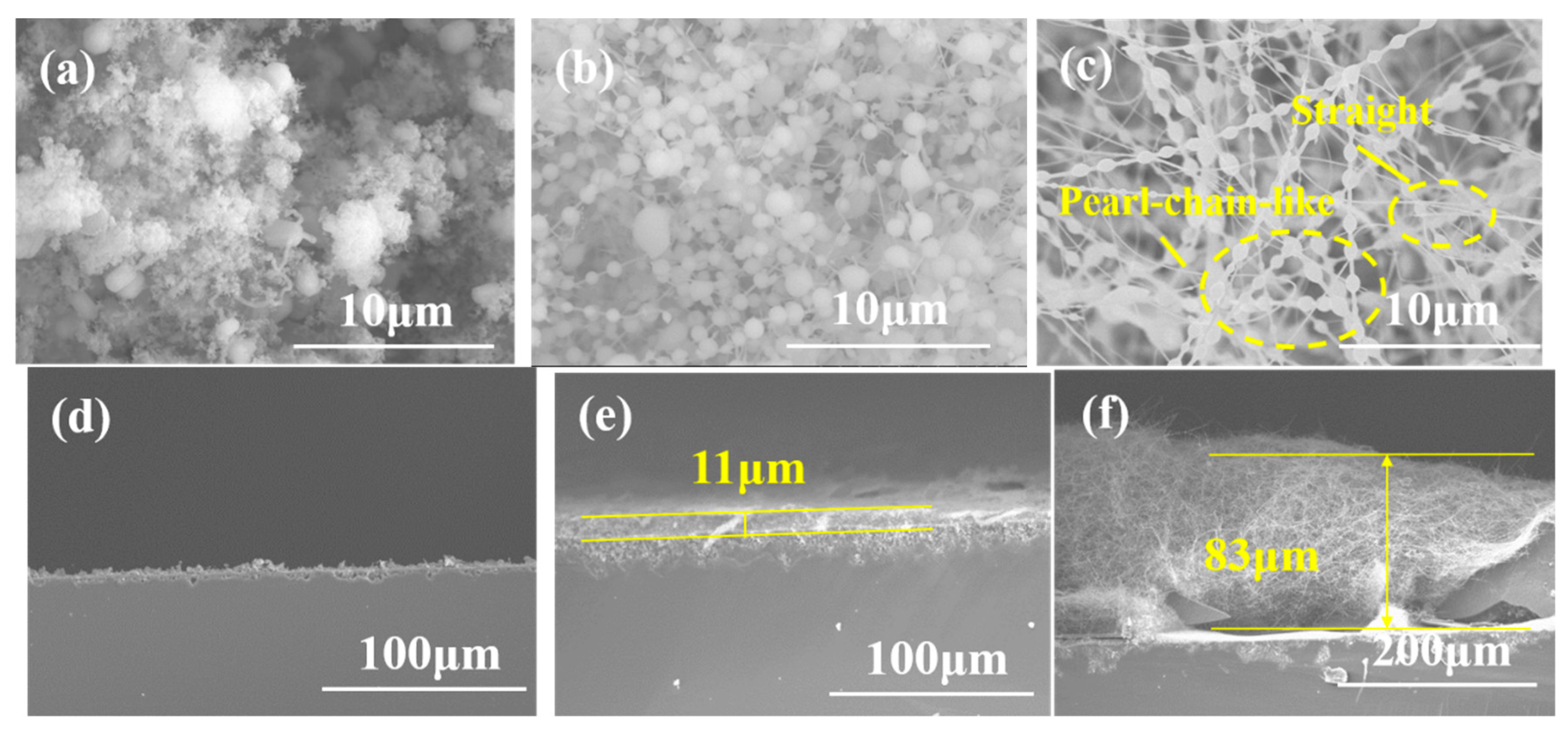

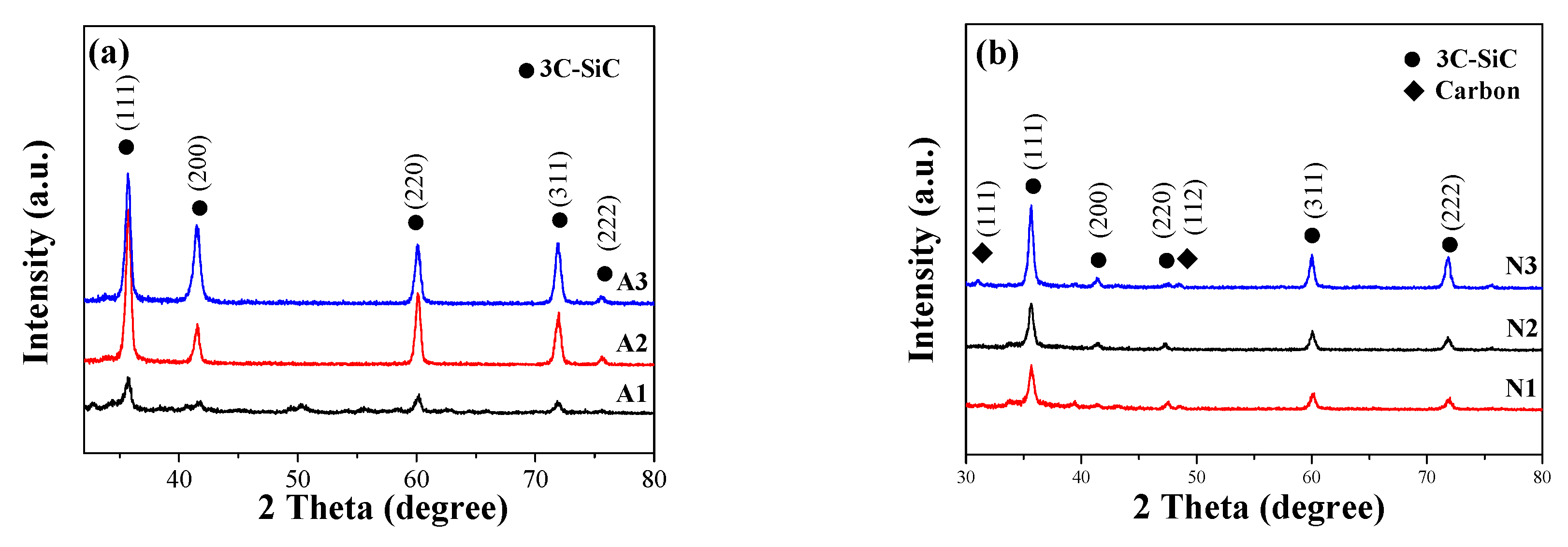
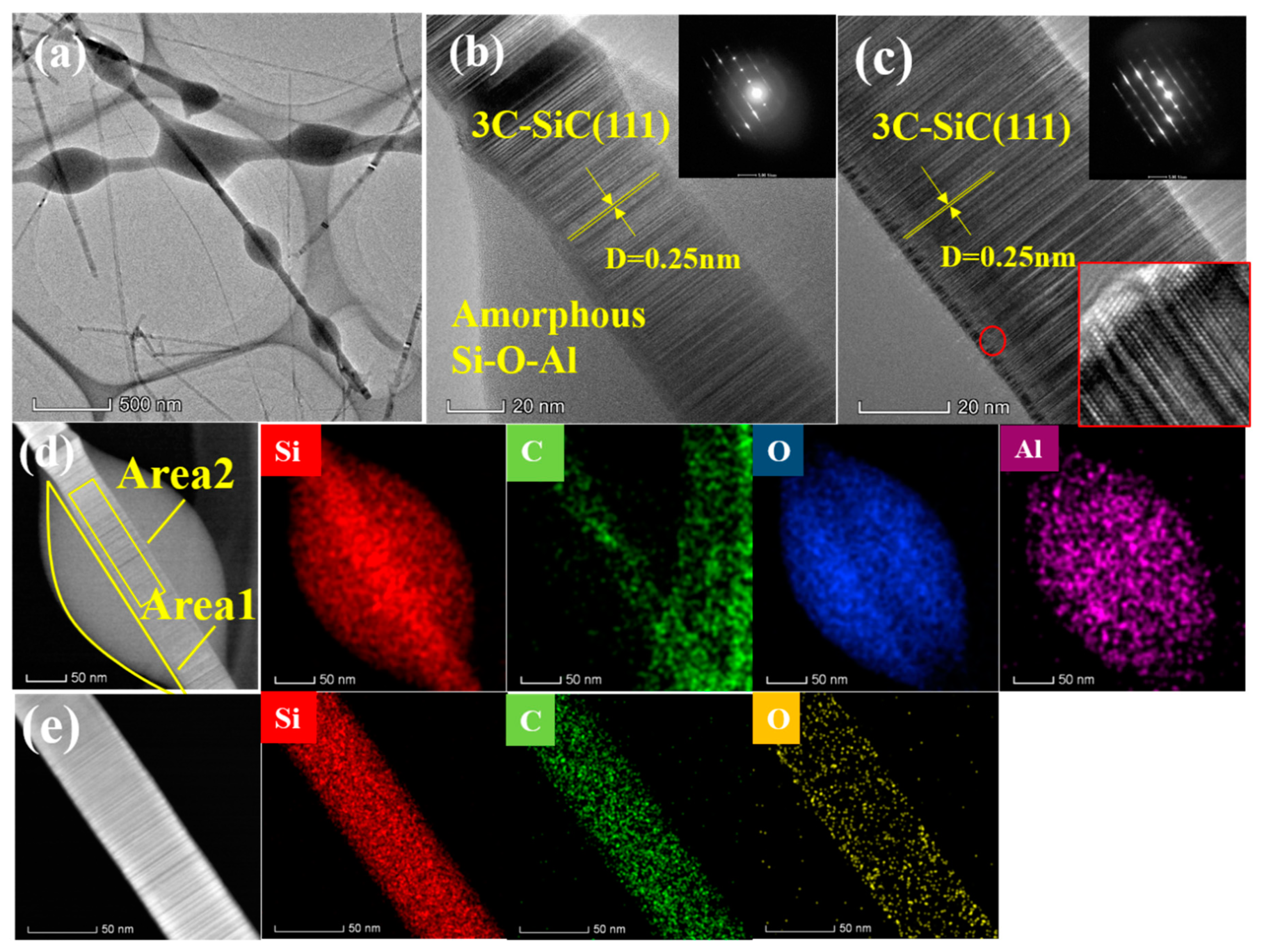
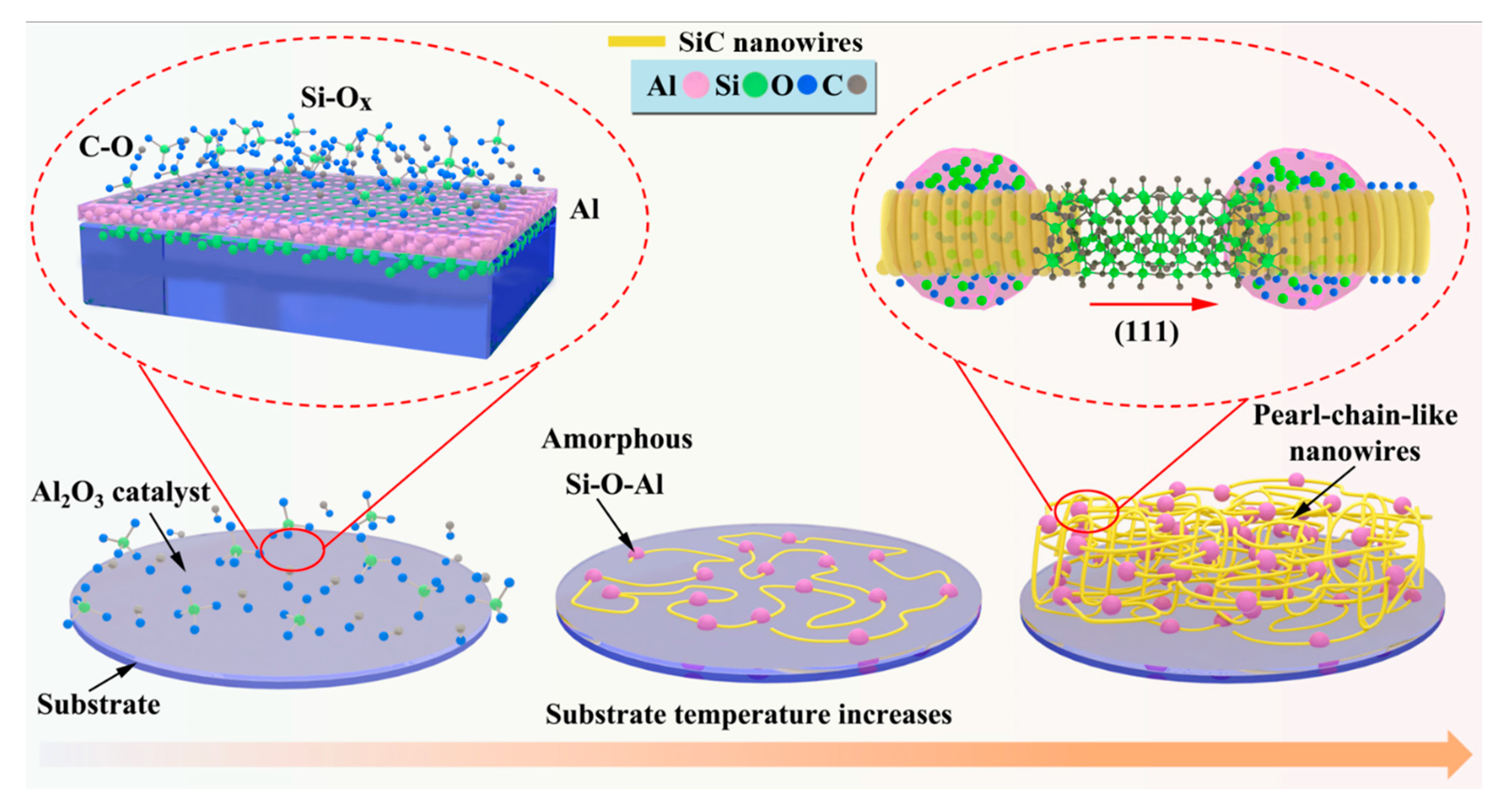
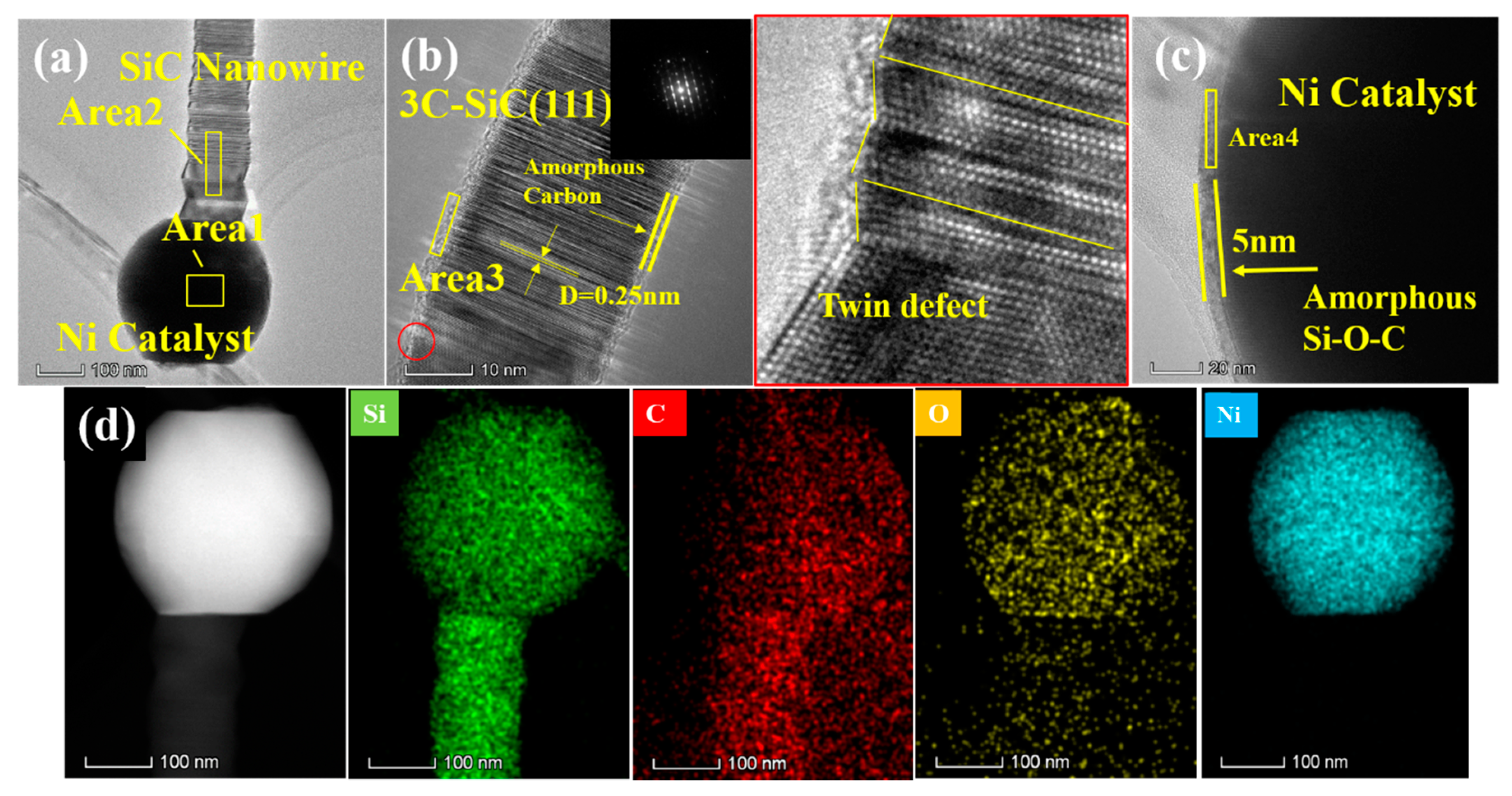
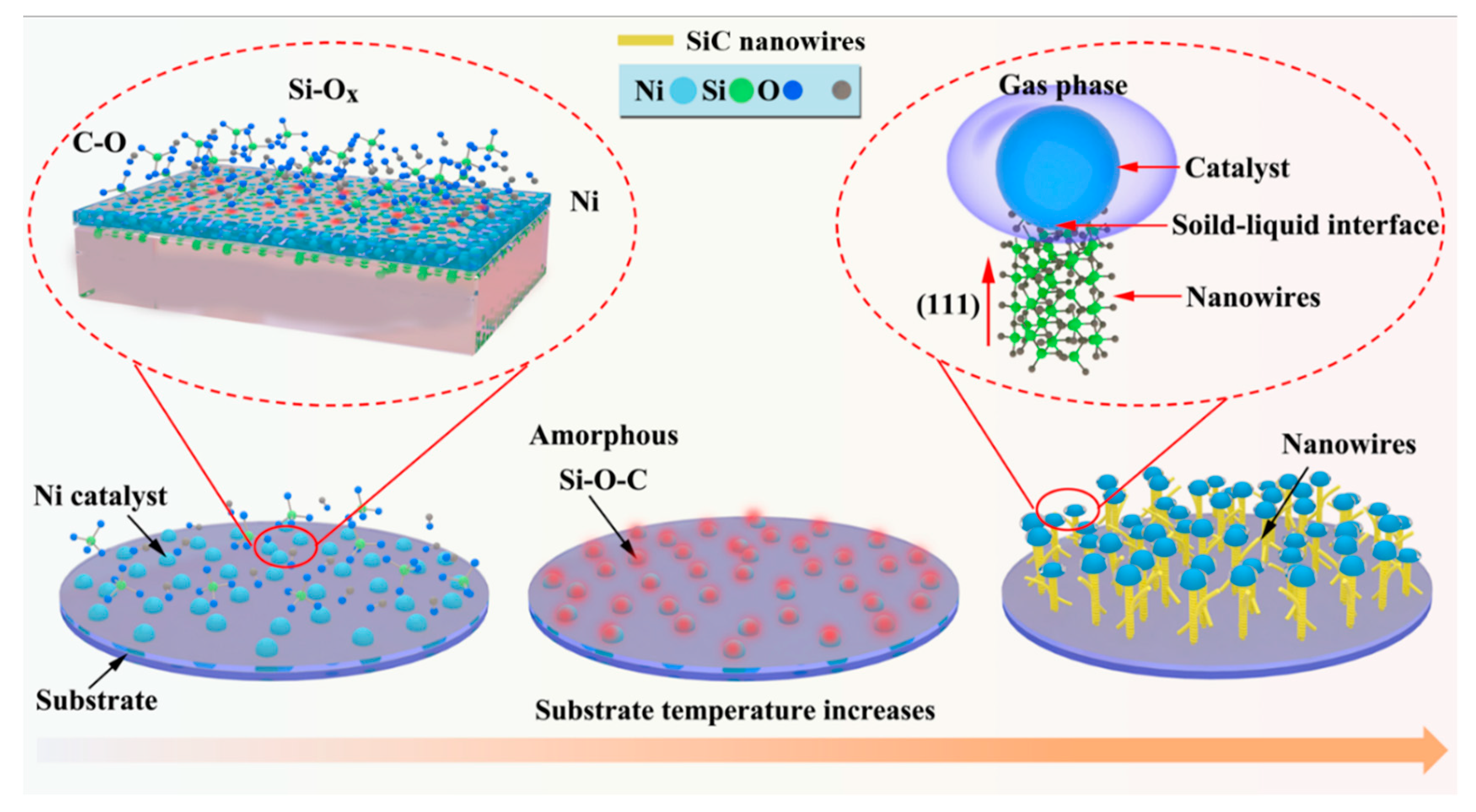
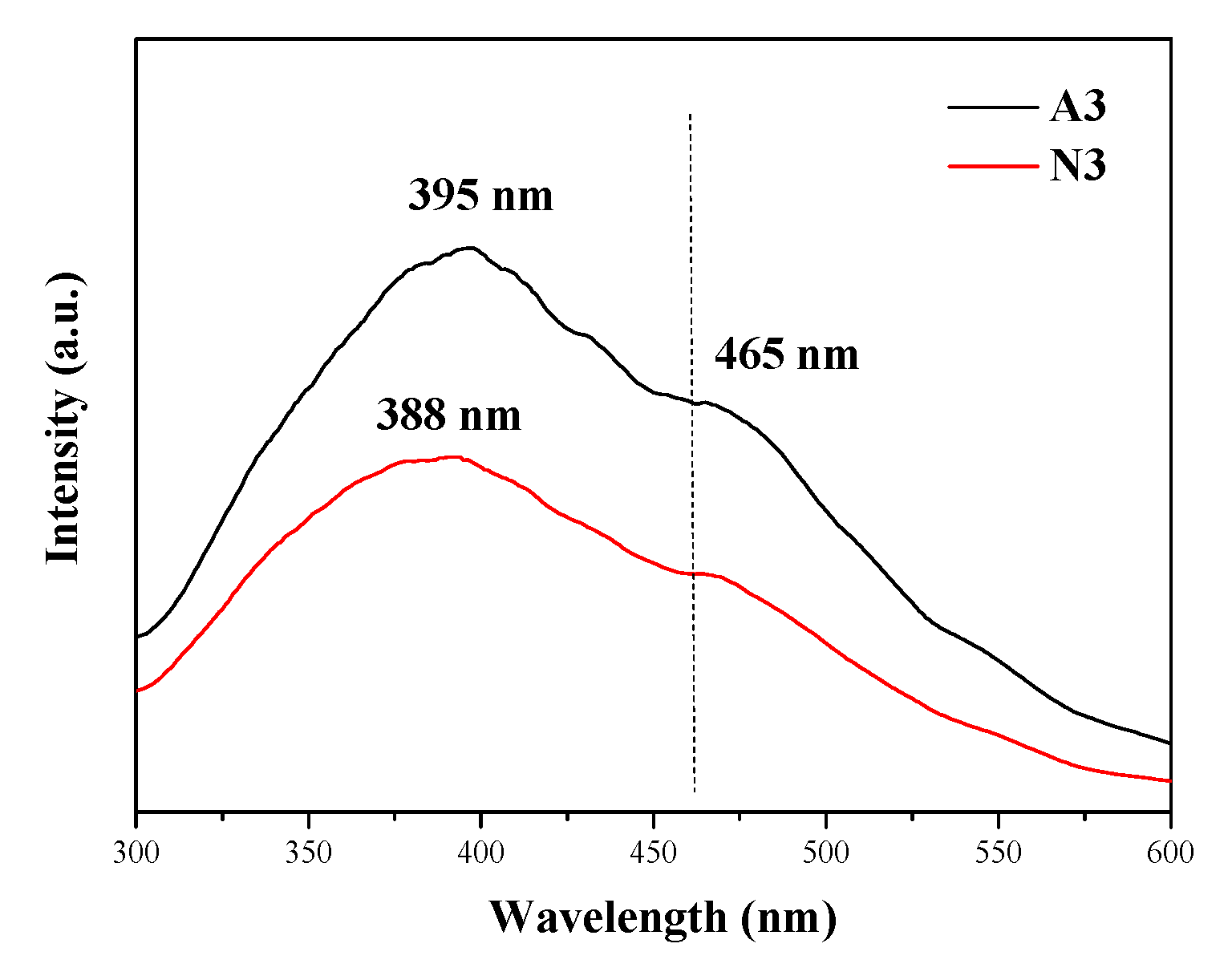
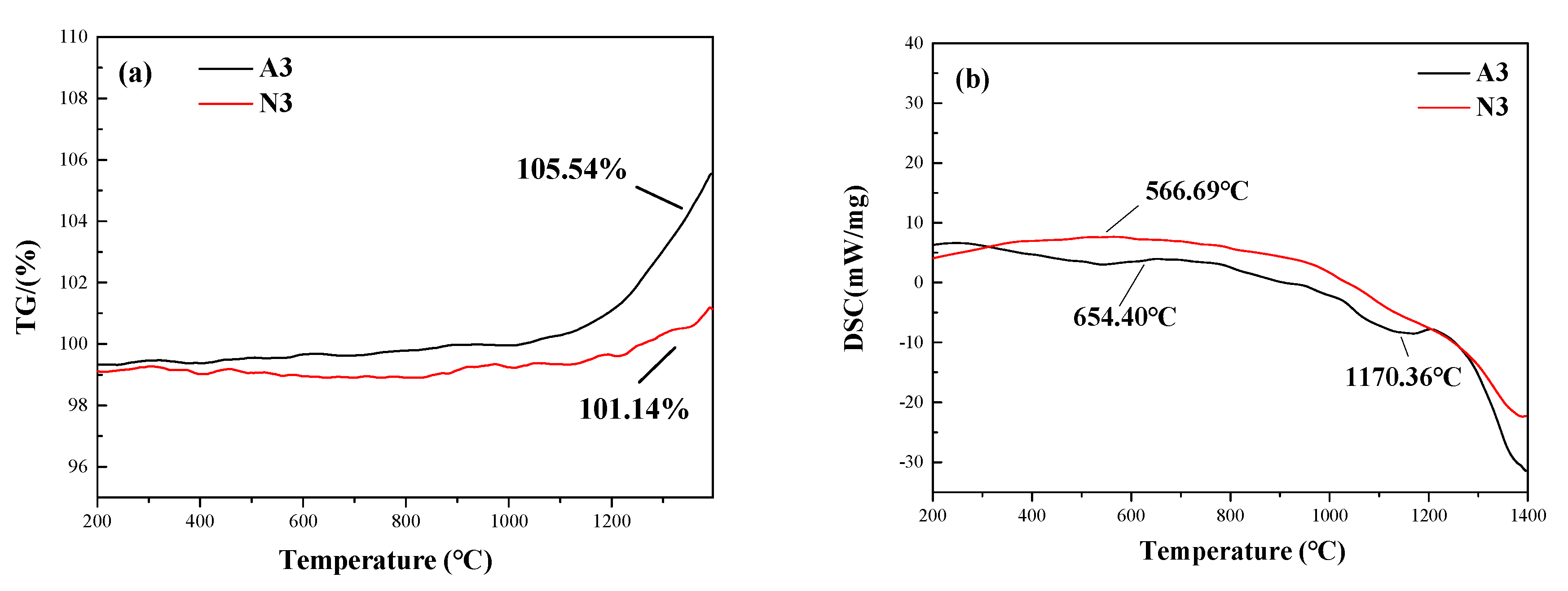
| Sample | Crystallinity/% | Crystallite Size/nm |
|---|---|---|
| A3 | 35.6 | 21.1 |
| N3 | 22.3 | 14.3 |
| Element | Si | C | O | Al | |
|---|---|---|---|---|---|
| Atomic Fraction (%) | |||||
| Area 1 | 29.53 | 2.06 | 63.39 | 5.01 | |
| Area 2 | 52.81 | 44.54 | 2.65 | – | |
| Element | Si | C | O | Ni | |
|---|---|---|---|---|---|
| Atomic Fraction (%) | |||||
| Area 1 | 12.91 | 7.79 | 1.54 | 77.76 | |
| Area 2 | 49.05 | 48.57 | 2.38 | – | |
| Area 3 | 11.68 | 79.43 | 8.89 | – | |
| Area 4 | 48.24 | 44.85 | 6.92 | – | |
Publisher’s Note: MDPI stays neutral with regard to jurisdictional claims in published maps and institutional affiliations. |
© 2020 by the authors. Licensee MDPI, Basel, Switzerland. This article is an open access article distributed under the terms and conditions of the Creative Commons Attribution (CC BY) license (http://creativecommons.org/licenses/by/4.0/).
Share and Cite
Guo, C.; Cheng, L.; Ye, F.; Zhang, Q. Adjusting the Morphology and Properties of SiC Nanowires by Catalyst Control. Materials 2020, 13, 5179. https://doi.org/10.3390/ma13225179
Guo C, Cheng L, Ye F, Zhang Q. Adjusting the Morphology and Properties of SiC Nanowires by Catalyst Control. Materials. 2020; 13(22):5179. https://doi.org/10.3390/ma13225179
Chicago/Turabian StyleGuo, Chuchu, Laifei Cheng, Fang Ye, and Qing Zhang. 2020. "Adjusting the Morphology and Properties of SiC Nanowires by Catalyst Control" Materials 13, no. 22: 5179. https://doi.org/10.3390/ma13225179
APA StyleGuo, C., Cheng, L., Ye, F., & Zhang, Q. (2020). Adjusting the Morphology and Properties of SiC Nanowires by Catalyst Control. Materials, 13(22), 5179. https://doi.org/10.3390/ma13225179




